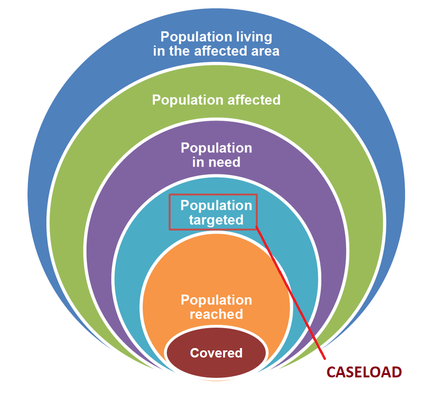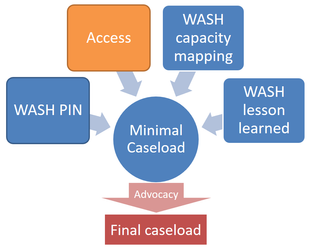Humanitarian caseload
Estimate the WASH sector humanitarian caseload
The cluster caseload represents the total number of people targeted by all partners of a cluster for the planned response. It should not be confused with the Population in Need (PIN), or the population reached or covered:
- WASH People in Need is the total number of people in need for WASH assistance during a humanitarian crisis. They usually cannot be all reached, because of lack of capacity, funding or access issues.
- A more realistic target is therefore defined for the response, called caseload, or population targeted
- People reached by one or more activities are called the population reached, even if these activities are not done using agreed standards, and do not produce the expected change.
- When people are reached by activities done according to agreed standards and leading to the expected change for the beneficiaries, they can be considered as “covered”
| Humanitarian Population Figures | How to calculate WASH Cluster caseload |
There is no consolidated cross-sector method to calculate a cluster caseload. OCHA often provides harmonized methodology at country level. The following approach can nevertheless be adapted and contextualized:
Rationale: The WASH humanitarian caseload is the part of WASH People in Need (PIN) that will be targeted considering operational constraints. Main constraints are access to target area (road access, security) and operational, technical and financial capacities of partners. If capacity was maximal and access not an issue, the whole population in need could be targeted, and the caseload would be the PIN. But as there are always constraints, the PIN must be reduced accordingly to obtain the minimal caseload, that can later be increased through advocacy. Use the following steps (refer to the diagram above):
- Use the WASH PIN numbers for each region as a starting point.
- Gather information on access and WASH sector capacity
- Based on the access and the capacity level, as well as the lesson learned from past emergencies, estimate how many people can be reached by WASH partners in each region: this is your minimal caseload.
- Consider the gaps between the PIN and the minimal caseload in each region.
- Define priority regions where advocacy for improvement of access and capacity will be focused
- Estimate how the minimal caseload can be increased in priority region through advocacy: this new figure is your final caseload
Even if this figure seem unrealistic at first, an important gap between people in need and the people targeted by the response is morally not acceptable as per cluster principles, and the issue must be communicated to the wider audience in advocacy messages.
Key web links

